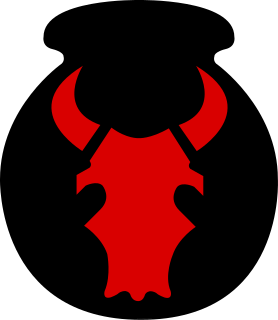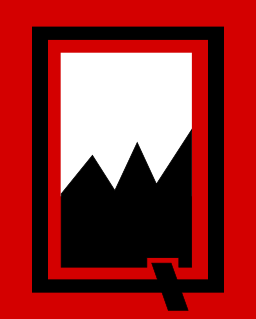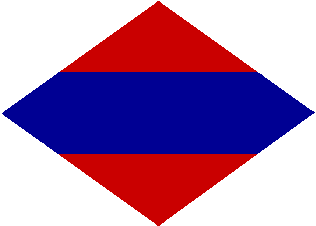Related Research Articles

The 4th Indian Infantry Division, also known as the Red Eagle Division, is the infantry division name the Indian Army retained after the present India adopted its entire rank and structure from its parent Army, the British Army.

The British Indian Army during World War II began the war, in 1939, numbering just under 200,000 men. By the end of the war, it had become the largest volunteer army in history, rising to over 2.5 million men in August 1945. Serving in divisions of infantry, armour and a fledgling airborne force, they fought on three continents in Africa, Europe and Asia.

The 34th Infantry Division is an infantry division of the United States Army, part of the National Guard, that participated in World War I, World War II and multiple current conflicts. It was the first American division deployed to Europe in World War II, where it fought with great distinction in the Italian Campaign.
39th Indian Infantry Division was an infantry division of the Indian Army during World War II, which became a Training Division in 1943 after its recovery into India from Burma.

The Queen's Own Royal West Kent Regiment was a line infantry regiment of the British Army based in the county of Kent in existence from 1881 to 1961. The regiment was created on 1 July 1881 as part of the Childers Reforms, originally as the Queen's Own , by the amalgamation of the 50th Regiment of Foot and the 97th Regiment of Foot. In January 1921, the regiment was renamed the Royal West Kent Regiment and, in April of the same year, was again renamed, this time as the Queen's Own Royal West Kent Regiment.

The 5th Indian Infantry Division was an infantry division of the Indian Army during World War II that fought in several theatres of war and was nicknamed the "Ball of Fire". It was one of the few Allied divisions to fight against three different armies - the Italian, German and Japanese armies.

The 8th Mountain Division was raised as the 8th Indian Infantry division of the British Indian Army. It is now part of the Indian Army and specialises in mountain warfare.

The 19th Indian Infantry Division was an infantry division of the Indian Army during World War II, and played a prominent part in the final part of the Burma Campaign.
The 6th Infantry Division was an infantry division of the Indian Army during World War II, created on 1 March 1941 in Secunderabad. On 11 September 1941 it was shipped to the Iraq and later Iran. During 1942 and 1943 it was part of the Tenth Army. The division remained in the Middle East where it was disbanded on 15 October 1944 in Basra, Iraq. During World War II its commanders included Major-General James Noel Thomson, Major-General Arthur Holworthy, and Major-General B.H. Chappel.

The 10th Indian Infantry Division was a war formed infantry division of the Indian Army during World War II. In four years, the division travelled over 4,000 miles (6,400 km) from Tehran to Trieste, fought three small wars, and fought two great campaigns: the Anglo-Iraqi War, the Invasion of Syria-Lebanon, the Anglo-Soviet invasion of Iran, the North African Campaign, and the Italian Campaign.

The Malaya Command was a formation of the British Army formed in the 1920s for the coordination of the defences of British Malaya, which comprised the Straits Settlements, the Federated Malay States and the Unfederated Malay States. It consisted mainly of small garrison forces in Kuala Lumpur, Penang, Taiping, Seremban and Singapore.

The 14th Indian Infantry Division was an infantry division of the Indian Army during World War II. It fought in the Arakan Campaign 1942–43, and was subsequently converted into a Training Division, providing drafts of replacements for units of the Fourteenth Army during the Burma Campaign.

The 26th Indian Infantry Division, was an infantry division of the Indian Army during World War II. It fought in the Burma Campaign.
The 11th Indian Infantry Division was an infantry division of the Indian Army during World War II. It formed part of Indian III Corps in the Malaya Command during the Battle of Malaya.
Iraqforce was a British and Commonwealth formation that came together in the Kingdom of Iraq. The formation fought in the Middle East during World War II.

The 25th Indian Infantry Division was an infantry division of the Indian Army during World War II which fought in the Burma Campaign. It was re-raised within the post-independence Indian Army in 1948.

The 31st Indian Armoured Division was an armoured division of the Indian Army during World War II, formed in 1940, originally as the 1st Indian Armoured Division; it consisted of units of the British Army and the British Indian Army. When it was raised, it consisted of two Armoured Brigades and one Motor Brigade.
The 9th (Secunderabad) Division was an infantry division formation of the British Indian Army. It was part of the Southern Army and was formed in 1904 after Lord Kitchener was appointed Commander-in-Chief, India between 1902 and 1909. He instituted large-scale reforms, including merging the three armies of the Presidencies into a unified force and forming higher level formations, eight army divisions, and brigading Indian and British units. Following Kitchener's reforms, the British Indian Army became "the force recruited locally and permanently based in India, together with its expatriate British officers."
The 34th Indian State Forces Infantry Brigade was an Infantry formation of the Indian Army during the Second World War.

The First Canadian Army was a field army and a formation of the Canadian Army in which most Canadian elements serving in Northwest Europe were assigned. During the Second World War it served on the Western Front from July 1944 until May 1945.
References
- ↑ The Indian Army 1914-1947 By Ian Sumner, p. 25
- ↑ Liddell Hart Centre for Military Archives
- ↑ "No. 35446". The London Gazette . 6 February 1942. p. 611.
- ↑ "34 Division units". Order of Battle. Archived from the original on 2012-06-03. Retrieved 2009-10-22.